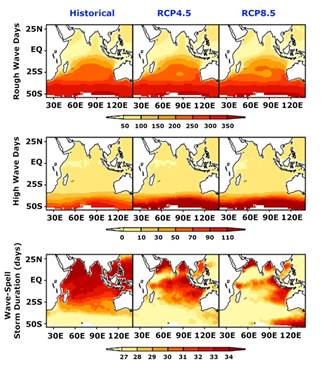Physical Address
23,24,25 & 26, 2nd Floor, Software Technology Park India, Opp: Garware Stadium,MIDC, Chikalthana, Aurangabad, Maharashtra – 431001 India
Physical Address
23,24,25 & 26, 2nd Floor, Software Technology Park India, Opp: Garware Stadium,MIDC, Chikalthana, Aurangabad, Maharashtra – 431001 India

Indian Ocean, northern Arabian Sea, and central Bay of Bengal are anticipated to witness an increase in rough wave days in the near future because of climate change, according to a recent research on extreme wave events. Particularly in coastal locations, this research could aid in prompt warning and preparedness to prevent catastrophic consequences on life and property.
The extreme wave height indices over the Indian Ocean were predicted by a team of scientists from the Department of Applied Sciences at the National Institute of Technology in Delhi, the Indian Institute of Technology in Kharagpur, and the Indian National Centre for Ocean Information Services in Hyderabad. The researchers used COWCLIP2.0 datasets in their research, which was published in the journal “Climate Dynamics,” to demonstrate that the large-scale distribution of future wave climate can differ dramatically from the current.
“Future projections by the scientists Divya Sardana and Prashant Kumar from the Department of Applied Sciences, NIT Delhi, Prasad K. Bhaskaran from the Department of Ocean Engineering & Naval Architecture, IIT Kharagpur, and T. M. Balakrishnan Nair from ESSO-INCOIS Hyderabad indicate that under the climate scenario RCP4.5 (medium representative concentration pathway of greenhouse gases), the regions over eastern tropical Indian Ocean, northern sector of Arabian Sea, and central Bay of Bengal showed a strong positive increase in rough wave days,” a release on the study said.
“However, under a high-emission scenario corresponding to RCP8.5, a decreasing trend in rough wave days is likely over most of the regions in the Indian Ocean, with an exception of regions in the north Arabian Sea and extra-tropical regions beyond 48° S in the Southern Indian Ocean sector,” the release added.

The study also found that changes in high wave days are projected to intensify over the South Indian Ocean under both RCP 4.5 and 8.5 scenarios, and the wave-spell-storm duration is found to strengthen over the northern Arabian Sea and Bay of Bengal, southeast Indian Ocean and South Indian Ocean under RCP8.5 forcing scenario.
According to the study, predicted changes in the Southern Hemisphere’s high-frequency severe wave events’ amplitude are caused by shifts in the sea level pressure gradient, which is in line with SAM’s (Southern Annular Mode) forecasts for the period of the twenty-first century.
Benefits from the study
For both short- and long-term planning that can benefit the coastal population, the research funded by the Science Research and Engineering Board (SERB), an attached institution of the Department of Science & Technology (DST), Government of India, can be of great assistance to policymakers and decision-making authorities.
Extreme wave events, which have been observed relatively regularly recently, can have a significant impact on infrastructure, ocean-related activities, and the livelihoods of the coastal people. Shoreline modifications, erosion rates, flooding events, and other related coastal hazards can all be significantly influenced by observed variability and changes in extreme wave events as well as shifting storm intensity and paths.
Extreme waves brought on by climate change and its effects are still developing on both a regional and global level. Therefore, for effective coastal planning and management as well as a timely warning, a better understanding of the expected changes in the amplitude of high-frequency extreme wave events is required.
Comments are closed.
[…] Also, read this in English […]
[…] Also, read this in English […]